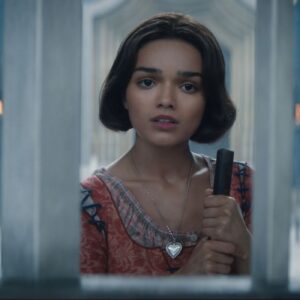
Expectations are high for horror fans eager to see “Alien: Romulus,” the seventh chapter in the iconic sci-fi franchise. It’s directed by Fede Álvarez, who helmed two blood-splattered modern horror classics: The 2013 “Evil Dead” remake and 2016’s “Don’t Breathe.” It’s set between the first two films in the series — 1979’s “Alien” and 1986’s “Aliens” — which are both considered cornerstones of the genre. Amazingly, it’s also the first feature of one of the film’s stars, Aileen Wu. In the film, Wu plays Navarro, a spaceship pilot who has some very close encounters with the aliens. Wu is a student of the craft, having attended both NYU’s Tisch School of the Arts and the Stella Adler Studio of Acting, but admits this experience had many large-scale, surreal moments. Wu spoke to Variety about the intense process of acting with aliens, learning how to pilot a spacecraft and the joy of shaving her head.
This is my first-ever feature. I got a self-tape request, as most actors do, I taped for it and then two days later I got a callback. Two days after that I was sent the full script, and then two days after that I was on a call with Fede and he was already in Budapest. During the call, I felt like he was trying to psych me out: “You know, you’re going to be covered in blood. You’re going to be sitting in this hole for eight hours. You can’t get out. You’re going to have this creature sitting on your face for a long time. You can’t get claustrophobic, are you claustrophobic?” I’m like, “No, I’m not claustrophobic.” I used to have a big claustrophobia problem back in high school. The next morning, my agent got the call from the studio and that’s when I got the official offer. Two days after that, I was on a plane to Budapest. It happened super fast, and I didn’t know what was going on until we had already started filming.
We shot the thing chronologically and one of the first big scenes is all of us in the space hauler. Navarro, my character, pilots the ship, and they bring a real pilot to come and talk to me and walk me through what all the language means, where all the buttons are, and why the sequence is like that. They practiced that sequence of flying the ship with me, or at least getting it off the ground.
Naaman Marshall, our production designer, did such an incredible job honoring Fede’s wish that everything is practical. Every button I could press and it would respond — it was that crazy. I didn’t know as an actor in 2024 I could have that experience on a film set. That’s when it hit me. I was like, “Holy shit, this is the dream.”
How familiar were you with the “Alien” franchise when you got the job?
I have an older brother who was a big fan of collecting action figures. He always had a Xenomorph sitting on his shelf. I didn’t know what it was when I was little, but I knew it looked different because it was next to Thor and Captain America. I would ask, “What’s that thing? It doesn’t look heroic.” And he would say, “You don’t want to know — you’re too young. I’m going to save you. Trust me. I’m protecting you. I’m doing you a favor.” So it wasn’t until I landed the role and I was like, “OK, time to do some homework.” I watched the first one and my brother was correct — I was way too young.
When did you first realize that you were on the poster?
The day the poster was released it was on Instagram, X, Facebook and all the platforms. Some news outlets had featured it, and then it slowly trickled onto buses, bus stops, billboards, New York subway stations and taxis. Then my friends in Paris would send me a photo of the poster on the bus. And then it was all over Times Square. So it was a slow burn of me realizing my shaved head was dominating the world. It was great.
It’s a cool look!
I love it. I love my shaved hair. I shaved it for the first time in 2019, so I’ve rocked that hairstyle for a while. My friends and classmates in New York know me as “Shaved Head Aileen.” Everybody said, “That’s your shaved head. I know that head!”

Aileen Wu in “Alien: Romulus”, 2024. © Walt Disney Studios Motion Pictures / courtesy Everett Collection©Walt Disney Co./Courtesy Everett Collection
What was the process like when you had to wear the facehugger?
A group was in charge of the facehuggers and they had their own studios that they worked out of on set. When we were filming in Budapest, you walk into the building that they were stationed in and it felt like walking into Hugger Depot. There would be shelves and rows of just the tail, just the tongue, just different finger parts. That was my first introduction, and then we started rehearsing. The first thing they had me do was taste test a bunch of lube: This one’s strawberry, this one’s mango, this one’s pineapple, this one has no taste. For the practical, they would rub lube all over the hugger to have that glistening effect. When we got to shooting that bit, I think we shot that scene over three to four days. For the longer takes that we shot in the wide, those were challenging because the facehugger is very heavy — I think it weighs around three pounds. The middle part, where it’s around my mouth and nose, is hollowed out, but it’s still made out of silicone, so it’s not very easy to breathe.
Then they would wrap the fingers around my head and secure it in the back with a bunch of rubber bands to get it as tight as possible, and wrap the tail around my neck. For some shots, they would have a fishing line attached to the very tip, so that somebody could tug on it off-camera and it would tighten and look like it was choking me. Then there were the bladders on the hugger that hung out around this cheek-area where you can see the hugger breathing, which I had to match my breathing to as well because story-wise that’s how the creature keeps the victim alive while it’s doing its thing. I struggled a lot because it’s a long take of me hitting the ground, thrashing around, struggling. Spike [Fearn], who plays my brother Bjorn, trying to take that off my face and passing out after getting choked out by the tail and then immediately having to match my breathing was very intense. It was like a balloon pump and it had a very long syringe. That was controlled by someone off-set, just pumping the thing throughout the entire scene. Sometimes I would mess it up and then I would think, “Ah, it’s fine. I’m doing enough.”
You also have the iconic chestburster death, complete with an X-ray to see it moving around your insides. What was the process like shooting that?
The chestburster was made by Alec Gillis and his team, and they worked on the original “Alien” movies, so that was fun to hang out with them on set and hear a bunch of stories about Sigourney Weaver. The franchise is 45 years old and they were in their 20s, how old I am now, when they started working on those films — that was special.
That scene also took about half a week to shoot. There were three different prosthetic parts. The first one was a piece with a pump and a balloon inside to show that it was my rib cage. The second day, I had to lie in a hole in the ground and they attached a very big piece starting at my collarbone. I was wearing a whole chest, and it was like a front backpack. For that one, there was a lever that was attached to a hydro pump and it would pop open. The chest was hollow, and they would put the little chestburster puppet through the fake chest and it would come out.
Someone had controllers to control the head and the hand and the sac. Then you can hear Fede on the radio during each take, directing the puppeteers: “Make it go towards its Mama! He wants to feel close to his Mama,” and then the hugger would lie on my chest while I’m laying there, twitching and dying and foaming. There’s a lot of lemon juice and, I think, baking powder or baking soda to make it really foamy. We did take after take, but I had [co-star] Isabela Merced with me those days, and she helped me a lot to soldier through that scene. She would say, “If you have five more in you, tell them that you have three more in you, so they don’t keep working you.” I love her for that, teaching me the tips and tricks of the trade as a newcomer. It’s really sweet of her to pass on some things she’d learned throughout the years since she’s been doing this for so long.

Aileen Wu at the premiere of “Alien: Romulus” held at TCL Chinese Theatre on August 12, 2024 in Los Angeles, California. (Photo by Gilbert Flores/Variety via Getty Images)Variety via Getty Images
Even though it’s chaotic, your death was so believable. What was your process like to convincingly die on camera?
I had to really trust Fede and his vision because I can’t relate to the dying, but I try to channel being in really intense physical pain, imagining what it would be like if there was actually something inside of me moving that’s foreign, that just appeared out of nowhere right after I passed out. But most of it was me leaning on Fede like, “Hey, I just did like a thing that I think might work. Did it work on camera?” Then it took a lot of conversation back and forth while we were filming the scene. Then you just try to not think about it too much because if it’s not working, he’ll let me know.
Are you worried about any of your friends and family freaking out when they have to watch you meet your demise?
I don’t care. It doesn’t matter — they have to go watch the film. It’s obligatory. I told all of my friends and family members, “Everyone must watch this film, unless you’re 70 years and above and have a heart condition. Then you can, for safety measures, stay at home.” But yeah, bring all your friends. Bring your neighbors. Everyone should see this film in theaters.
Did you have a pinch-me moment at the premiere?
[Producer] Ridley Scott gave me a fist bump right before we took a group photo. That was crazy. He was so chill about it.
This interview has been edited and condensed.


